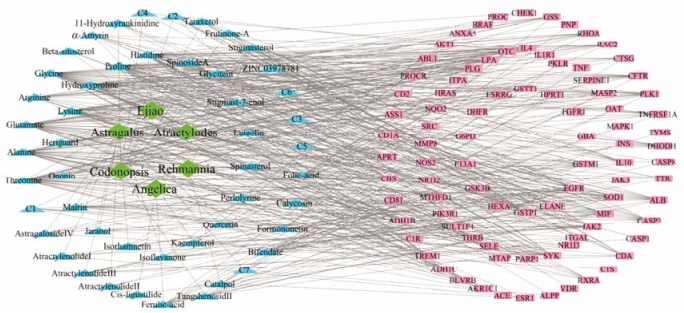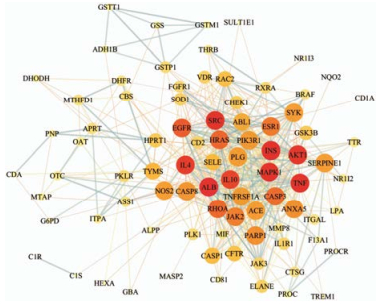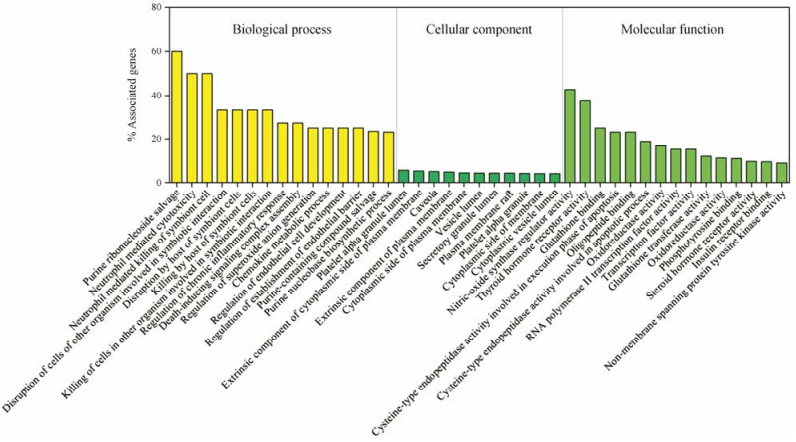2. 山西大学地产中药功效物质研究与利用山西省重点实验室, 山西 太原 030006;
3. 山西大学体育学院, 山西 太原 030006;
4. 九芝堂股份有限公司, 湖南 长沙 410205
2. Shanxi Key Laboratory of Active Constituents Research and Utilization of TCM, Shanxi University, Taiyuan 030006, China;
3. School of Physical Education, Shanxi University, Taiyuan 030006, China;
4. Jiuzhitang Co. Ltd. Hunan, Changsha 410205, China
驴胶补血颗粒是由湖南名老中医“五老”中的欧阳锜教授, 根据中医气血理论与“善补阴者, 必于阳中求阴”的独特经验精心研究组方, 由阿胶、黄芪、党参、当归、白术、熟地黄6味中药组成, 具有滋阴补血、健脾益气、调经活血之功效, 临床常用于久病体虚所引发的疾病[1-4]。而白细胞减少症属中医“血虚”、“虚劳”等范畴, 临床上因禀赋不足、后天失调、体质虚弱所致; 或诸病失治、病后失养, 或积劳成疾、形神过耗、渐至元气亏损、精虚血少、脏腑机能衰退、气血生化不足所致[5-8]。基于中医辨证论治的特点, 驴胶补血颗粒具滋阴补血、健脾益气等功效, 主治气血双亏引起的一系列病症, 因此认为其具有较好的升高白细胞的能力。然而, 由于中药复方化学成分的复杂性及多靶点的调节作用, 使得驴胶补血颗粒升高白细胞的作用机制难以明确, 因此借助网络药理学工具挖掘驴胶补血颗粒主要活性成分以及作用靶点, 进一步寻找信号通路与疾病的相关性, 从系统生物学角度整体阐释驴胶补血颗粒升高白细胞的作用机制具有重要意义。
网络药理学(network pharmacology)认为药物和疾病的作用是一个复杂体系, 其涉及多成分、多靶点、多途径的分子功能网络相互作用的过程, 通过单一药物、单一靶点来治疗疾病的方法存在很大弊端, 应针对疾病的复杂体系采用多成分药物协同治疗才能达到更佳的治疗效果, 这与中医药基础理论中的动态辩证观和整体观不谋而合[9-11]。因此网络药理学已发展成为研究中药药效物质基础, 阐明中药作用机制的新思路和新方法。Zhao等[12]采用ADME/T计算方法筛选百合地黄汤的活性成分, 依据TCMSP、Pharm Mapper和Medical Subject Headings等数据库对疾病分类预测和筛选百合地黄汤活性成分的作用靶点。筛选出11个活性成分, 共涉及神经和免疫等21个靶点, 主要参与GABA信号转导、cAMP信号通路以及单胺转运等相关生物过程。Zhang等[13]采用ADME/T计算方法筛选交泰丸活性成分, TCMSP、DRAR-CPI、文本挖掘工具(CooLGeN)预测和筛选交泰丸的活性成分及其抗抑郁作用靶点, 网络分析结果表明交泰丸中筛选得到28个活性成分, 涉及靶点38个, 主要通过参与神经营养因子信号通路、改善神经元细胞的生长发育等发挥抗抑郁作用。
因此, 本研究采用网络药理学方法预测驴胶补血颗粒升高白细胞作用主要活性成分的靶点, 探讨其多成分、多靶点、多通路的作用机制, 为驴胶补血颗粒作用机制的深入研究奠定基础。
材料与方法 主要化学成分收集利用中药系统药理学技术平台TCMSP (http://lsp.nwsuaf.edu.cn/index.php), 并结合文献[14-17]收集驴胶补血颗粒中6味药的主要化学成分, 并利用PubChem (https://pubchem.ncbi.nlm.nih.gov/)和Chemical Book (http://www.chemicalbook.com/)等平台对其分子结构进行确证。
活性成分的筛选口服生物利用度(OB)和类药性(DL)是中药成分ADME的关键参数。因此利用TCMSP数据平台[18, 19], 计算ADME/T值, 对OB、DL进行评估, 选取数据库中同时满足OB≥30%和DL≥0.18的化学成分以及文献报道的有活性的化合物作为候选活性成分。
预测潜在靶点DRAR-CPI服务器(http://cpi.bio-x.cn/drar)采用双向Z-变换函数转换成Z分数从而提高预测准确性[20], 服务器建议选取药物分子与蛋白质相互作用(chemical-protein)的Z-score < -0.5纳入为潜在靶点。因此, 登陆服务器上传筛选得到的驴胶补血颗粒候选活性分子的化学结构。下载计算结果, 为进一步缩小范围和提高预测准确度, 将蛋白靶点纳入标准设为Z-score < -1。筛选得到的蛋白靶点的PDB ID导入UniProt (http://www.uniprot.org/)数据库, 经过检索和转化操作得到驴胶补血颗粒活性成分的基因靶点。
在线文本挖掘服务器CooLGeN (http://ci.smu.edu.cn/CooLGeN/)可以通过输入关键词查找分析和关键词相关的人类基因。GeneCards数据库(http://www.genecards.org/)可以提供全面的人类基因数据。通过在两个数据库中输入leukopenia、leucopenia、leukocytopenia、neutropenia关键词搜索已报道的和白细胞减少症相关的基因, 去除重复和假阳性基因, 并逐一搜索文献验证。最后分别和驴胶补血颗粒活性成分潜在的基因靶点匹配, 得到驴胶补血颗粒活性成分的相关潜在靶点。
活性成分-作用靶点网络构建将上述预测结果输入Excel表格并导入Cytoscape (v3.5.1)软件, 采用Cytoscape (v3.5.1)软件的Merge功能将活性成分与潜在靶点构建活性成分-靶点网络。网络中, 节点(node)分别代表驴胶补血颗粒单味药、活性成分以及作用靶点。若某活性成分属于某单味药时, 则将单味药与活性成分以边(edge)相连; 若某一靶点为某活性成分的潜在作用靶点时, 则以边相连, 以此来体现驴胶补血颗粒多成分、多靶点的作用特点。
蛋白相互作用网络构建与分析String数据库(https://string-db.org/)收集了大量的蛋白相互作用关系[21], 通过将驴胶补血颗粒的蛋白靶点导入String数据库, 限定物种为人, 获取蛋白相互作用关系。将导出文件中的node1、node2和combined score信息导入Cytoscape软件绘制相互作用网络, 对网络进行分析, 并将节点大小和颜色设置用于反映degree的大小, 边的粗细设置用于反映combine score的大小, 获得最终的蛋白相互作用网络。
分子对接采用Systems Dock Web Site (http://systemsdock.unit.oist.jp, Version 2.0)对蛋白相互作用网络中degree值靠前的5个靶点与驴胶补血颗粒活性成分-作用靶点网络中degree值靠前的活性成分进行分子对接验证。并采用临床应用广泛的升高白细胞化学药物维生素B4作为阳性药物进行对照分析。
生物功能与通路分析生物学信息注释数据库(DAVID, https://david.ncifcrf.gov/, Version 6.8)为大规模的基因或蛋白提供系统综合的生物功能注释信息, 能够找出最显著富集的生物学注释。将驴胶补血颗粒的作用靶点导入DAVID数据库, select identifier设置为official gene symbol, list type设置为gene list, 限定物种为人, 对驴胶补血颗粒作用靶点进行GO分析和KEGG通路分析, 保存结果。设定阈值P < 0.05, 并按照涉及的靶点数目多少进行排序, 筛选排名靠前的生物过程或通路, 用GraphPad Prism 5.0软件绘图。
作用靶点类型归属DisGeNET数据库(http://www.disgenet.org/web/DisGeNET/menu, Version 5.0)是包含与人类疾病相关的基因和变体的平台之一。在基因和疾病关系中, 该数据库一方面可以通过输入基因获取该基因相关的疾病信息, 另一方面还可以通过输入疾病获取与该疾病相关的基因信息。在DisGeNET数据库中选用基因进行检索, 将上述驴胶补血颗粒的主要作用靶点依次导入数据库中, 获取靶点类型信息(protein class)。
结果 1 驴胶补血颗粒中活性成分的筛选根据OB、DL值筛选到符合此条件的32种化学成分, 结合参考文献再加入17种, 共49种。结果见表 1。
| Table 1 Main active ingredients in Lvjiao Buxue granules. C1: 7-Methoxy-2-methyl-3-phenyl-4H-chromen-4-one; C2: 3-Beta-hydroxymethyllenetanshiquinone; C3: 1, 7-Dihydroxy-3, 9-dimethoxy pterocarpene; C4: 8S, 9S, 10R, 13R, 14S, 17R)-17-[(E, 2R, 5S)-5-Ethyl-6-methylhept-3-en-2-yl]-10, 13-dimethyl-1, 2, 4, 7, 8, 9, 11, 12, 14, 15, 16, 17-dodecahydrocyclopenta [a] phenanthren-3-one; C5: (3R)-3-(2-Hydroxy-3, 4-dimethoxyphenyl)chroman-7-ol; C6: Poriferasta-7, 22E-dien-3beta-ol; C7: 7-O-Methylisomucronulatol |
驴胶补血颗粒49个活性成分在DRAR-CPI服务器中Z-score < -1的靶点去重复后共有361个。通过向Uniprot数据库中输入蛋白靶点后共得到1 033个基因靶点。通过与GeneCards和CoolGeN数据库中与白细胞减少症相关的基因进行比对, 筛选出89个可能与驴胶补血颗粒治升高白细胞相关的作用靶点, 结果如表 2所示。
| Table 2 Information of protein targets elevating leukocytes with Lvjiao Buxue granules |
将驴胶补血颗粒活性成分-作用靶点的信息导入Cytoscape (v3.5.1)构建活性成分-作用靶点网络, 见图 1。不同颜色和形状的节点分别代表药材、潜在活性成分和作用靶点, 绿色菱形节点代表单味药材, 蓝色三角形节点代表主要活性成分, 粉红色矩形节点代表作用靶点, 边代表活性成分和作用靶点间的相互关联, 图中共涉及144个节点, 524个边, 充分体现了驴胶补血颗粒多成分、多靶点的作用特点。对活性成分-作用靶点做网络分析具有较大degree值的活性成分与靶点见表 3。

|
Figure 1 Herbs-components-targets network of Lvjiao Buxue granules. The green ellipse (   |
| Table 3 Important targets and ingredients with big degree of Lvjiao Buxue granules |
将上述作用靶蛋白导入String数据库, 获取蛋白相互作用关系, 并采用Cytoscape软件绘制相互作用网络, 详见图 2。图中节点表示蛋白, 边表示蛋白之间的关联, 共涉及85个节点, 556个边。节点的大小和颜色表示degree值的大小(括号中的数字表示degree值), 节点越大, 颜色由浅变深对应的degree值越大。边的粗细表示combine score, 边越粗combine score值越大。其中排名前10名的蛋白包括ALB (59)、TNF (42)、INS (41)、MAPK1 (38)、SRC (37)、AKT1 (36)、IL4 (35)、IL10 (33)、EGFR (31)和RHOA (29)。

|
Figure 2 Protein interaction network of Lvjiao Buxue granules |
上述相互作用网络中degree表示某个蛋白具有相互作用的蛋白的数目。一般而言, 在一个网络中, 只有少数的节点具有很高的degree, 这些节点为“中枢节点”, 在整个网络中占据重要的地位。将上述排名前5的靶点与表 3中排名靠前的活性成分及阳性对照药维生素B4进行分子对接验证, 对接结果见表 4和表 5。分子对接结果表明, 主要活性成分与重要靶点的结合活性较好, 且与阳性对照药docking score值相接近。
| Table 4 Molecular docking of five important targets from Lvjiao Buxue granules |
| Table 5 Molecular docking of five important targets from vitamin B4 |
将作用靶点导入DAVID数据库中, 进行GO富集分析。图 3显示GO富集分析中3个分支生物过程(biological process, BP)、细胞组分(cellular component, CC)和分子功能(molecular function, MF)的前15个。其中BP分析靠前的有嘌呤核糖核苷的合成(purine ribonucleoside salvage)、嗜中性粒细胞介导的细胞毒性(neutrophil mediated cytotoxicity)、嗜中性粒细胞介导的共生细胞凋亡(neutrophil mediated killing of symbiont cell)、共生细胞宿主的破坏(disruption by host of symbiont cells)等, 主要与嘌呤核糖核苷的合成、中性粒细胞死亡调控和氧化应激等有关。CC分析靠前的有血小板α颗粒内容物(platelet alpha granule lumen)、细胞膜胞质侧的外在成分(extrinsic component of cytoplasmic side of plasma membrane)、膜小凹(caveola)等, 主要与血小板糖膜蛋白、囊腔等膜结构有关。MF分析靠前的有一氧化氮合酶调节剂活性(nitric-oxide synthase regulator activity)、甲状腺激素受体活性(thyroid hormone receptor activity)、谷胱甘肽结合(glutathione binding)、寡肽结合(oligopeptide binding)等, 主要与转录因子、氧化还原酶、细胞凋亡相关酶的活性调节及激素受体、DNA结合调节等有关。

|
Figure 3 Enriched gene ontology terms for biological process, cellular component and molecular function of potential targets elevating leukocytes from main active ingredients of Lvjiao Buxue granules |
KEGG分析结果如图 4所示, 通路中涉及的与驴胶补血颗粒升高白细胞作用相关的靶点数目分别为代谢通路(metabolic pathways, 23)、癌症通路(pathways in cancer, 15)、PI3K-Akt信号通路(PI3K-Akt signaling pathway, 13)、癌症蛋白多糖(proteoglycans in cancer, 12)、Rap1信号通路(Rap1 signaling pathway, 12)、趋化因子信号通路(chemokine signaling pathway, 11)、MAPK信号通路(MAPK signaling pathway, 11)等。

|
Figure 4 Enriched KEGG pathways of potential targets elevating leukocytes with main active ingredients of Lvjiao Buxue granules |
将驴胶补血颗粒的89个作用靶点依次导入DisGeNET数据库, 获取靶点对应的类型, 见表 6。结果表明驴胶补血颗粒升高白细胞过程中有酶调节剂、信号分子、转录因子、受体、蛋白(防御/免疫蛋白、转运蛋白、载体蛋白等)、酶(氧化还原酶、丙酮酸激酶、蛋白酶、水解酶、异构酶等)等物质的参与。
| Table 6 The protein class of potential targets elevating leukocytes with main active ingredients of Lvjiao Buxue granules |
本研究借助网络药理学方法, 探讨驴胶补血颗粒升高白细胞作用的物质基础及其分子机制, 发现其通过调节metabolic、cancer、tuberculosis、PI3K-Akt signaling等多条通路发挥升高白细胞作用。此外, 结果发现阿胶中多种氨基酸成分具有较大的degree值, 因此驴胶补血颗粒中升高白细胞作用的主要物质基础可能仍然是阿胶。
文献报道, 阿胶中甘氨酸、精氨酸、谷氨酸等氨基酸具有提高血清补体活性、促进T淋巴细胞增殖、调节免疫等功能[22-24]。阿魏酸(ferulic acid)可以调节Bcl-2、Bax的表达等, 促进辐射后小鼠外周血白细胞的恢复, 促进造血祖细胞集落的生长[25]。黄芪中黄酮类成分可升高血清中细胞因子IL-4水平[26], 皂苷类成分可促进SOD的表达[27]。上述分子对接结果表明, 丁子香萜(mairin)与2个重要靶点具有强烈结合活性, 提示丁子香萜可能具有较强升高白细胞作用。此外, 课题组前期通过代谢组学方法研究驴胶补血颗粒改善环磷酰胺所致的小鼠白细胞减少症[28], 与本次网络药理学预测相互佐证, 可证明结果的准确性。
在活性成分-作用靶点与蛋白相互作用两个网络的构建过程中, 发现其共有的具有较大degree值的靶点为EGFR、ALB和IL4, 提示这3个靶点在成分和靶点相互作用中起关键作用。研究表明, EGFR、ALB和IL4主要与造血细胞及白细胞增殖、氧化应激、调节免疫等功能相关[29-31], 因此推测驴胶补血颗粒可能会通过作用于这3个靶点来达到升高白细胞的作用, 该结论需进一步的生物学实验验证。
GO富集分析与靶点归属分析结果表明, 靶基因涉及嘌呤核糖核苷的合成、细胞死亡调控和氧化应激等生物过程; 涉及血小板糖膜蛋白、囊腔等细胞膜组分; 涉及转录因子、氧化还原酶、细胞凋亡相关酶的活性调节以及激素受体、DNA结合调节等分子功能。说明驴胶补血颗粒通过调控白细胞的生成、生长、转移、凋亡; 调控白细胞中相应基因表达与蛋白质合成; 调节细胞酶活性等, 发挥升高白细胞的作用。
KEGG分析结果显示, 驴胶补血颗粒升高白细胞作用的活性成分相关靶点涉及参与代谢通路、癌症相关通路、癌症蛋白聚糖、调节肌动蛋白细胞骨架、PI3K-Akt、Rap1、趋化因子、MAPK等多条信号通路。本实验室前期基于代谢组学的方法通过对小鼠白细胞减少症的研究, 发现白细胞减少症可能涉及能量代谢、氨基酸代谢、氧化应激等代谢途径[32]。PI3k-Akt信号通路在细胞增殖、细胞凋亡、DNA修复和蛋白质合成的细胞反应中起关键作用[33]。趋化因子是指能够吸引白细胞转移到感染部位的一些低分子质量的蛋白质, 在炎症反应中具有重要作用[34]。癌症相关通路、PI3K-Akt、趋化因子信号通路与白细胞减少症有密切关系, 其中PI3K-Akt可能是重组灵芝免疫蛋白发挥升白作用的通路。MAPK信号通路参与调节细胞生长、分化以及炎症反应等多种重要的细胞生理/病理过程[35]。表明驴胶补血颗粒可从调节代谢, 促进生长因子, 调控白细胞生长、分化、转移以及参与炎症反应等多个方面发挥升高白细胞的作用。
网络药理学结果显示驴胶补血颗粒中的49个活性成分作用于89个靶点, 涉及多种过程、分子和通路, 体现了驴胶补血颗粒多成分-多靶点-多途径的作用特点。组方中阿胶氨基酸成分对作用靶点的贡献最大, 体现了“主病之谓君”的配伍原则。此外, 文献报道中黄芪多糖和当归多糖等对白细胞减少症也有一定的作用[36, 37], 但由于多糖类物质结构的特殊性使得其不能通过网络药理学来体现其作用。因此, 今后应结合分子生物学、代谢组学和蛋白质组学等多种技术, 全面系统研究驴胶补血颗粒升高白细胞作用机制, 阐明中药复方升高白细胞作用的整体观念及遣方用药的配伍精髓。
| [1] | Liu CH, Liu H, Gu ZX, et al. Mechanisms of tonifying blood with Lvjiao Buxue granules studied by 1H-NMR metabolomics[J]. Chin Tradit Herb Drugs (中草药), 2016, 47: 1142–1148. |
| [2] | Chen HY, Li JP, Li WL, et al. Determination of donkey-hide gelatin in Lvjiao Buxue granules by UPLC-QQQ/MS[J]. J China Pharm (中国药房), 2017, 28: 2101–2104. |
| [3] | Ou JX, Gu ZX, Zhang NY, et al. Determination of 6 amino acids in Lujiao Buxue Keli by pre-column derivation HPLC[J]. Chin J Exp Tradit Med Formulae (中国实验方剂学杂志), 2012, 18: 93–96. |
| [4] | Liu XS, Li MR, Wang ZY, et al. Study on concentrating process of Lvjiao Buxue granule by near infrared spectroscopy[J]. Chin Tradit Herb Drugs (中草药), 2016, 47: 3997–4002. |
| [5] | Li H, Ma Q, Ai P, et al. Treatment of chemotherapy-induced leucopenia in patients with malignant tumor by Chinese herbal medicine:a systematic review and meta-analysis of randomized clinical trials[J]. Chin J Integr Med (中国中西医结合杂志), 2015, 35: 157–166. |
| [6] | Li H, Zhang RR. Analysis on prescription patterns in Chinese medicine compounds in the treatment of leukopenia[J]. J Tradit Chin Med (中医杂志), 2015, 56: 338–341. |
| [7] | Zhao XQ, Chen YL. Clinical study on Shengxue decoction in treatment of leukopenia patients experienced chemotherapy with acute myeloid leukemia[J]. Acta Chin Med (中医学报), 2017, 32: 704–707. |
| [8] | Feng C, Zhang P, Huang Z. Clinical research on leucopenia after multiple myeloma treated by Diyushengbai tablet[J]. Acta Chin Med (中医学报), 2013, 28: 1794–1795. |
| [9] | Hopkins AL. Network pharmacology:the next paradigm in drug discovery[J]. Nat Chem Biol, 2008, 4: 682–690. DOI:10.1038/nchembio.118 |
| [10] | Liu AL, Du GH. Network pharmacology:new guidelines for drug discovery[J]. Acta Pharm Sin (药学学报), 2010, 45: 1472–1477. |
| [11] | Wang YH, Yang L. Systems pharmacology-based research framework of traditional Chinese medicine[J]. World Chin Med (世界中医药), 2013, 8: 801–808. |
| [12] | Zhao L, Wu YF, Gao Y, et al. Intervention mechanism of psychological sub-health by Baihe Dihuang Tang based on network pharmacology[J]. Acta Pharm Sin (药学学报), 2017, 52: 99–105. |
| [13] | Zhang X, Gao Y, Xiang H, et al. An exploration on mechanism of antidepression of Jiaotai Pills based on network pharmacology[J]. Chin Tradit Herb Drugs (中草药), 2017, 48: 1584–1590. |
| [14] | Guo ZK, Wang KZ, Ji GX, et al. Advances on chemical composition, identification and pharmacology of Colla Corii Asini[J]. J Liaoning Univ Tradit Chin Med (辽宁中医药大学学报), 2015, 17: 71–74. |
| [15] | Cheng BL, Miao MS. Research and characteristics of Ejiao[J]. Acta Chin Med (中医学报), 2015, 30: 415–417. |
| [16] | Zhao YJ, Gao Y, Zhou YZ, et al. Research progress on pharmacological effect and mechanism of Atractylodes macrocephala in nervous-mental system diseases[J]. Chin Tradit Herb Drugs (中草药), 2017, 48: 4546–4551. |
| [17] | Sun ZH, Shao J, Guo M. Research progress of Codonopsis pilosula chemical component and pharmacological effects[J]. J Anhui Agric Sci (安徽农业科学), 2015, 43: 174–176. |
| [18] | Zhang WJ, Wang YH. The theory and methods of systems pharmacology and its application in traditional Chinese medicine[J]. World Chin Med (世界中医药), 2015, 10: 280–286. |
| [19] | Ru J, Li P, Wang J, et al. TCMSP:a database of systems pharmacology for drug discovery from herbal medicines[J]. J Cheminform, 2014, 6: 13. DOI:10.1186/1758-2946-6-13 |
| [20] | Luo H, Chen J, Shi L, et al. DRAR-CPI:a server for identifying drug repositioning potential and adverse drug reactions via the chemical-protein interactome[J]. Nucleic Acids Res, 2011, 39: W492–W498. DOI:10.1093/nar/gkr299 |
| [21] | Von Mering C, Jensen LJ, Snel B, et al. STRING:known and predicted protein-protein associations, integrated and transferred across organisms[J]. Nucleic Acids Res, 2005, 33: D433–D437. |
| [22] | Razak MA, Begum PS, Viswanath B, et al. Multifarious beneficial effect of nonessential amino acid, glycine:a review[J]. Oxid Med Cell Longev, 2017, 2017: 1716701. |
| [23] | Geiger R, Rieckmann JC, Wolf T, et al. L-Arginine modulates T cell metabolism and enhances survival and anti-tumor activity[J]. Cell, 2016, 167: 829–842. DOI:10.1016/j.cell.2016.09.031 |
| [24] | Dutta S, Ray S, Nagarajan K. Glutamic acid as anticancer agent:an overview[J]. Saudi Pharm J, 2013, 21: 337–343. DOI:10.1016/j.jsps.2012.12.007 |
| [25] | Tan HL, Ma ZC, Zhao YH, et al. Effect of ferulic acid and its derivatives on survival rate of irradiated mice[J]. Pharm J Chin PLA (解放军药学学报), 2014, 30: 507–508. |
| [26] | Sun JB, Fan Y, Li N, et al. Effect of astragalus active ingredients on IL-1β and IL-4 in diabetic rats[J]. Chin J Tradit Chin Med Pharm (中华中医药杂志), 2012, 27: 1908–1910. |
| [27] | Zhang L, Zhou YP, Liu GW. Therapeutic effects of astragalus saponin on rats with atrophic gastritis and MyD88, TLR4 receptor[J]. Chin J Exp Tradit Med Formulae (中国实验方剂学杂志), 2013, 19: 226–229. |
| [28] | He XY, Yan L, Xu XP, et al. Investigation on positive effect and possible mechanisms of Lvjiao Buxue granules treatment on cyclophosphamide-induced leucopenia mice through 1H-NMR based metabolomics approach[J]. Chin Tradit Herb Drugs (中草药), 2018, 10: 2282–2290. |
| [29] | He Z, Long MH, Jie W, et al. Ginseng alleviates cyclophosphamide-induced hepatotoxicity via reversing disordered homeostasis of glutathione and bile acid[J]. Sci Rep, 2015, 5: 17536. DOI:10.1038/srep17536 |
| [30] | Sheng J, Yang YP, Zhao YY, et al. The efficacy of combining EGFR monoclonal antibody with chemotherapy for patients with advanced non-small cell lung cancer:a meta-analysis from 9 randomized controlled trials[J]. Medicine, 2015, 94: e1400. DOI:10.1097/MD.0000000000001400 |
| [31] | Liu F, Zhang H, Xie RM. Effects of Zhuzishen on leukopenia induced by cyclophosphamide in mice[J]. Mod Tradit Chin Med (现代中医药), 2015, 35: 164–168. |
| [32] | Qu TL, Wang EB, Li ZY, et al. Metabolomics of ethyl acetate extract from Huangqi injection on leucopenia mice[J]. Chin Tradit Pat Med (中成药), 2017, 39: 455–461. |
| [33] | Andrade GM, da Silveira JC, Perrini C, et al. The role of the PI3K-Akt signaling pathway in the developmental competence of bovine oocytes[J]. PLoS One, 2017, 12: e0185045. DOI:10.1371/journal.pone.0185045 |
| [34] | Nagarsheth N, Wicha MS, Zou W. Chemokines in the cancer microenvironment and their relevance in cancer immunotherapy[J]. Nat Rev Immunol, 2017, 17: 559–572. DOI:10.1038/nri.2017.49 |
| [35] | Shuaib A, Hartwell A, Kiss-Toth E, et al. Multi-compartmentalisation in the MAPK signalling pathway contributes to the emergence of oscillatory behaviour and to ultrasensitivity[J]. PLoS One, 2016, 11: e0156139. DOI:10.1371/journal.pone.0156139 |
| [36] | Cheng JF, Zhang Y, He JR. Effect of astragalus polyaaccharudcs on the decrease of the leukcocytes and the marrow karyotes in chemotherapy mice[J]. Chin J Mod Appl Pharm (中国现代应用药学), 2003, 5: 378–380. |
| [37] | Li NC. The study survey on the effect of polysacchrides in promoting leucocyte growth[J]. Int Med Health Guid News (国际医药卫生导报), 2006, 21: 103–105. |
 2018, Vol. 53
2018, Vol. 53


